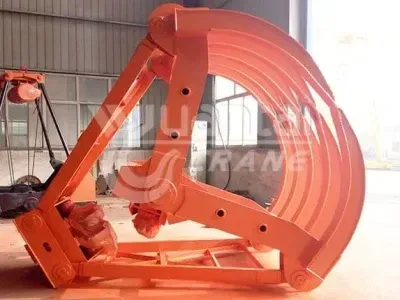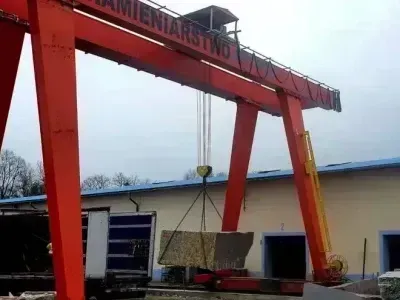- May 22, 2025
- News
Best Orange Peel Grabs for Scrap, Steel, and Waste Handling
Discover the top orange peel grabs for efficient scrap, steel, and waste handling. Evaluate their performance, durability, and suitability for your needs before making a purchase. Make informed choices to enhance your operations today!
An orange peel grabber is a attachment with four to six curved, wear-resistant steel tines, designed for handling irregular and loose bulk materials like scrap metal and construction debris. It is commonly used in recycling yards, steel mills, and waste transfer stations, and can be mounted on cranes or excavators. Controlled by a hydraulic system, the grabber minimizes material spillage and may include a 360-degree rotation feature for better positioning. Orange peel grabs come in many different types, depending on the type and volume of the material, different types and sizes of grabs need to be selected.
What Is Orange Peel Scratching?
Orange peel scratching describes the closing motion of the grabber's segments. Each tine swings radially to form a near-complete enclosure around material, much like peeling an orange in sections. When the power source activates, the segments converge. They clamp onto scrap, waste, sand, grain, or other bulk items. Once secured, the load is lifted and transported. This mechanism allows operators to handle irregular, mixed, or fine materials without spillage. The term “orange peel” comes from the shape of the enclosed tines, which resemble peel segments. Because it adapts to uneven shapes, the orange peel grabber excels where standard buckets or clamshells struggle.


Material Structural Components of the Orange Peel Grab
Orange peel grabs share several core parts, regardless of their power source. Their design ensures durability and reliable performance in tough environments. Each component is selected or treated to withstand mechanical stress, surface abrasion, and environmental exposure.
- Tines (Claws): These are curved or angular segments fabricated from high-tensile or abrasion-resistant steel. The tines interlock when closed, forming an enclosure that can grip loose or irregular materials such as scrap metal, waste, or bulk ores. They are often bolted or welded to the hinge arms, allowing for replacement or maintenance as needed.
- Central Body (Shell): The central body serves as the grab's structural core. It houses the main pivot points, bearing assemblies, and linkage anchors. This part provides the structural base to which all tines are connected. Made from reinforced steel plates or cast steel sections, the central body supports the dynamic loads generated during repeated opening and closing cycles. Internal components are sealed or shielded to prevent debris ingress.
- Linkage and Pins: The linkage mechanism translates the linear movement from actuators into synchronized radial motion of the tines. The system includes precision-machined pins, bushings, clevis joints, and connecting links. Pins are typically made from heat-treated alloy steel, while bushings and sleeves incorporate bronze or polymer composites for reduced friction. This configuration helps maintain consistent movement and reduces the risk of seizure or misalignment during prolonged use.
- Power Actuator: Depending on the model, the power source can be hydraulic cylinders or electric actuators. These components generate the mechanical force required to open and close the tines. Hydraulic cylinders are the most common due to their high force capacity and smooth operation. Cylinders are fitted with seals and wipers to prevent oil leakage and contamination from dust or moisture.
- Rotary Joint or Swivel (Optional): Some models feature a built-in rotary actuator or hydraulic swivel that enables full 360° rotation of the grab independently of the host equipment. This allows for flexible load positioning and more efficient material sorting. The rotary joint includes sealed bearings and a central fluid passage system to maintain consistent flow during rotation.
- Mounting Interface: The mounting component connects the grab to the crane, excavator, or loader. Configurations may include quick couplers, fixed flange mounts, or adapter plates. The interface is designed to match the host equipment's boom end and must support vertical and torsional loads generated during material lifting. Compatibility and ease of detachment are essential for systems requiring frequent tool changes.
- Control Valve or PLC Unit: Electric models, and some advanced hydraulic variants, include an integrated control system. A PLC unit or electronic controller manages the opening and closing sequences, pressure limits, and safety interlocks. The control panel may be mounted within the grab or remotely on the host equipment. For wireless systems, radio signal receivers handle control commands with built-in delay and fault detection systems.
To withstand corrosion, all components receive surface treatments such as powder coating, galvanizing, or nitriding. Non-destructive testing procedures are used to inspect critical load-bearing elements and ensure structural integrity. These design principles work together to ensure reliable performance in high-cycle and high-impact situations.


Main Features
Orange peel grabs integrate features designed for varied applications. These ensure efficient handling, low maintenance, and long service life.
1. Designed for Hard Materials
- Reinforced Tines: Thick steel sections resist bending when grabbing sharp metal or concrete debris.
- High-Strength Bolts: Secure tines to the central shell. Prevent loosening under shock loads.
- Overload Protection: Built-in pressure relief valves (hydraulic models) or torque limiters (electric models). Prevent actuator damage.
This design lets operators handle demolition rubble, dense scrap, and unprocessed ore without deforming the grab.
2. Wear Resistance
- Wear Plates and Liners: Removable, hardened-steel liners on tines and central body.
- Surface Hardening: Case-hardening or heat treatment on high-wear areas.
- Abrasion-Resistant Alloys: Use of manganese or chrome alloys for extreme wear resistance.
These measures extend maintenance intervals. They reduce parts replacement costs over the grab's lifespan.
3. Semi-Open or Closed Design
- Semi-Open Configuration: Tines are spaced to allow fine particles to fall through. Ideal for bulky items mixed with dust or small debris.
- Closed Configuration: Tines overlap closely to contain fine materials such as sand, gravel, or wood chips. Prevents spillage during lifting.
- Hybrid Models: Adjustable tine spacing or interchangeable segments allow quick conversion between semi-open and closed modes.
Selecting the right design optimizes cycle time and reduces material loss.
4. High Compaction and Jaw Force
- Multi-Stage Actuators: Hydraulic grabs often use two-stage cylinders for rapid approach and high-force closing.
- Force Multipliers: Linkage geometry amplifies actuator force at the tips.
- Load-Holding Valves: Maintain grip pressure when holding a load at height.
High clamping force secures heavy or awkward loads. It also compacts loose bulk for more efficient transport.
5. Robust Construction and Special Bearings
- Alloyed Structural Steel: Frames and tines made from S355 or equivalent.
- Self-Lubricating Bearings: Reduce the need for frequent greasing. Suitable for dusty or abrasive environments.
- Case-Hardened Pins: Withstands shear loads during operation.
- Corrosion-Resistant Coatings: Epoxy or powder coats protect against salt and chemicals.
These elements ensure the grab operates smoothly under extreme conditions and minimizes downtime for repairs.
Orange Peel Grab Applications
Orange peel grabs serve a broad range of industries. Their versatility makes them an asset wherever bulk handling is needed.
1. Waste Sites
- Mixed Municipal Waste: Separates oversized items from general refuse.
- Recyclable Sorting: Handles paper, plastic, and metal for processing lines.
- Landfill Management: Loads waste into compactors or trucks.
The semi-open design allows light debris to fall through, speeding up sorting.
2. Steel Mills
- Scrap Metal Handling: Picks up loose scrap, cuttings, and turnings.
- Slag Removal: Clears slag from furnaces or ladle pits.
- Dust Control: Closed grabs reduce airborne particles when handling fine metal dust.
High wear resistance is critical when dealing with sharp-edged scrap.
3. Ports
- Bulk Cargo Loading: Handles coal, limestone, ore, and grain.
- Breakbulk Operations: Moves timber, steel sections, and bagged commodities.
- Ship-to-Shore Transfers: Efficiently loads and unloads ships using crane-mounted orange peel grabs.
High compaction ensures minimal spillage during ship handling and transport.
4. Construction Sites
- Demolition Debris: Loads concrete chunks, bricks, and rebar.
- Excavated Material: Moves soil, gravel, and sand into trucks or hoppers.
- Site Cleanup: Clears loose material and debris between phases.
Electric or pneumatic grabs can reduce noise and hydraulic-fluid spill risks in urban settings.
Types of Orange Peel Grabs
Choosing the right orange peel grab involves matching capacity, tine count, and power source to your needs. If you want to know more about the orange peel grabber, you can refer to this previous article.
By Tine Count
- Two-Tine Models: Lightweight grabs for small excavators and loaders. Best for bulky, oversized items.
- Four-Tine Standard: Versatile for scrap yards, waste sites, and basic demolition.
- Five- and Six-Tine Variants: Offer more enclosure. Ideal for fine or small-particle materials.
By Actuation
- Hydraulic Grabs: Most common. Provide high force and rapid cycle times. Require carrier with compatible hydraulic flow.
- Pneumatic Grabs: Use compressed air. Suitable for light-duty and dust-sensitive environments. Lower force but cleaner operation.
- Electric Grabs: Powered by onboard or external electric motors. Offer precise control and minimal fluid leak risk. Best for indoor or environmentally sensitive sites.
- Mechanical (Linkage-Only) Grabs: Operate via manual or simple mechanical leverage. Rare, but useful where no power source is available.
By Additional Features
- Swivel Grabs: Include a 360° rotating joint. Enhance positioning flexibility on cranes or long-reach excavators.
- Quick-Coupler Compatible: Enable rapid tool changes. Ideal for contractors switching between bucket, grapple, and grab.
- Dust Cover and Skirt: Enclose the top of the grab to contain dust and small particles. Common in recycling and demolition of hazardous materials.
Safety Precautions
Proper operation of orange peel grabs is critical to avoid injury and equipment damage. Follow these safety guidelines:
Pre-Operation Checks
- Visual Inspection: Look for cracked tines, loose pins, and damaged hoses or cables.
- Function Test: Cycle the grab through full open/close. Listen for unusual noises. Check for smooth movement.
- Pressure and Flow Verification: Ensure hydraulic or pneumatic systems supply the correct specifications.
Safe Operating Practices
- Load Within Limits: Do not exceed the grab's rated capacity. Overloading can cause structural failure or loss of control.
- Maintain Clear Zones: Keep personnel and bystanders out of the swing radius and under raised loads.
- Use Spotters and Communication: Coordinate with ground crews using radios or hand signals.
- Avoid Shock Loading: Lower the grab smoothly onto piles; do not smash into material. This reduces stress on components.
- Secure Attachment: Check quick couplers or mounting bolts before each shift. Ensure safety locks engage properly.
Maintenance and Repairs
- Regular Lubrication: Grease pivot points and bearings per manufacturer intervals.
- Replace Worn Components: Swap out liners, seals, and hoses at first sign of excessive wear.
- Hydraulic Fluid Checks: Monitor fluid levels and quality. Change filters as recommended.
- Lockout/Tagout: Deactivate power and relieve pressure before servicing the grab. Secure tines in the open position.
- Periodic Load Testing: Verify gripping force and structural integrity under controlled conditions.
Conclusion
Orange peel grabbers are flexible instruments used for bulk material handling in trash management, steel production, ports, and construction. Understanding orange peel scratching, structural components, and critical features, as well as matching grab type to application, can help you maximize efficiency. Following safety rules and performing regular maintenance increases service life and assures safe operation. Whether you choose a hydraulic, pneumatic, electric, or mechanical grasp, the correct orange peel grabber will make loading, sorting, and cleanup easier.




